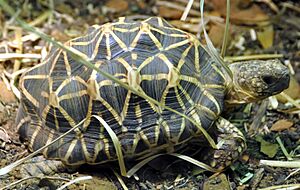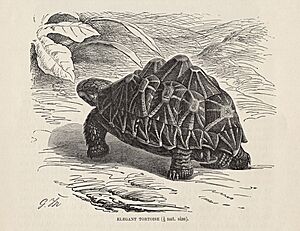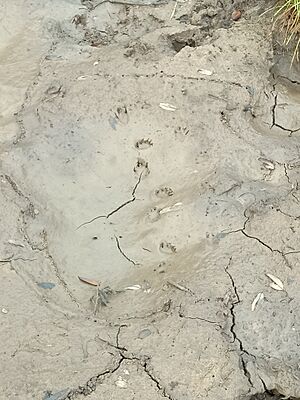Indian star tortoise facts for kids
Quick facts for kids Indian star tortoise |
|
|---|---|
 |
|
| Conservation status | |
| Scientific classification | |
| Genus: |
Geochelone
|
| Species: |
elegans
|
| Synonyms | |
|
|
The Indian star tortoise (Geochelone elegans) is a special kind of tortoise. It lives in dry areas and scrub forests. You can find it in countries like India, Pakistan, and Sri Lanka. This tortoise is considered a vulnerable animal. This means its numbers are going down.
Since 2016, it has been on the IUCN Red List. This list tracks animals that might be in danger. Experts think there are over 10,000 of these tortoises left. But their population is shrinking. They are threatened by things like losing their homes. This is called habitat loss. They are also threatened by poaching, which is illegal hunting. People poach them to sell them as pets.
In 2019, the Indian star tortoise got more protection. It was added to CITES Appendix I. This is the highest level of international protection. It means it's illegal to trade them for money. A group called TRAFFIC found many tortoises being sold illegally. About 6,040 were caught trying to be sold as pets. Even so, many are now bred in captivity. This helps meet the demand for pets.
Contents
About the Indian Star Tortoise
The shell of the Indian star tortoise is very rounded. It often has bumps on its back. The sides of its shell are almost straight up and down. The back edge is a bit wider and has a saw-like shape.
The tortoise has no neck shield. The shield above its tail is one piece. It curves inward on male tortoises. The shields on its shell have clear rings. These rings show how the tortoise grows. The first shield on its back is longer than it is wide. Other shields are wider than they are long.
The bottom shell, called the plastron, is big. It is flat or slightly curved at the front. At the back, it has a deep notch. The head is a normal size. Its forehead is rounded and covered with small, uneven shields. The tortoise's mouth is slightly hooked. The edges of its jaws are bumpy.
The front legs have many large, pointed bumps. These bumps overlap like scales. The heel has large, spur-like bumps. There are also big, cone-shaped bumps on the back of the thigh.
The shell is black with yellow spots. Yellow lines spread out from these spots. These lines are usually thin and many. The bottom shell also has black and yellow lines. An Indian star tortoise can grow up to 10 inches long.
The patterns on their shells are very bright. But they help the tortoise hide. This is called disruptive coloration. It breaks up the tortoise's shape. This makes it hard to see when it sits in the shade.
Indian star tortoises mostly eat plants. They are herbivores. They munch on grasses, fallen fruit, flowers, and leaves. Sometimes, they might eat dead animals. But if you have one as a pet, never feed it meat.
Male and Female Differences
Adult male and female Indian star tortoises look different. This is called sexual dimorphism. Females are much bigger than males. Also, female plastrons are flatter. Males have a shell that curves inward on the bottom.
How They Right Themselves
The unique shape of this tortoise helps it flip back over. If it gets turned upside down, it can often get back on its feet. Scientists studied this special ability. They found that the tortoise's shape helps it return to a stable position.
Two mathematicians designed a special object. It was shaped so it would always return to one stable spot. They noticed it looked like the Indian star tortoise. They then tested 30 tortoises. Many of them could flip themselves back over.
Where They Live and Their Homes
Indian star tortoises live in parts of western and southeastern India. They also live on the island of Sri Lanka and in southeastern Pakistan. There are no official subspecies. But tortoises from different areas look a bit different.

Tortoises from southeastern India are smaller. They have brighter, more contrasting patterns. Those from northern India are different. Tortoises in Sri Lanka often have wider yellow markings. They are also generally larger than those in India.
Scientists didn't know much about their differences until 2006. A study showed that tortoises from India and Sri Lanka are indeed distinct. These tortoises live in many different types of places. They can handle both dry and wet seasons. Star tortoises have been found in rainy forests. They also live in dry grasslands and even semi-deserts.
Reproduction and Life Cycle
Female tortoises usually start having babies when they are 8-12 years old. Males are ready to mate around 6-8 years old. Males will fight each other for mates. They ram into other males. They try to flip them onto their backs.
About 60-90 days after mating, the female looks for a spot to dig a nest. She then lays her eggs there. A female star tortoise can lay 1 to 9 groups of eggs each year. Each group can have 1 to 10 eggs.
After laying her eggs, she covers them with sand. The eggs need to stay warm for 50-180 days. A star tortoise egg has a hard but fragile shell. Each egg usually weighs 12-21 grams. When first laid, the eggs are a pinkish see-through color. After 2-3 weeks, they turn white.
The temperature of the nest decides if the babies will be male or female. If the temperature is between 28-30 degrees Celsius, most will be males. If it's between 31-32 degrees Celsius, most will be females. Baby tortoises don't have the clear star pattern. Their shells are black or brown. They have yellow rectangle shapes instead.
Illegal Pet Trade and CITES Protection
The Indian star tortoise is one of the most illegally traded tortoises. Even though they are from India, Pakistan, and Sri Lanka, they are found everywhere. This includes Southeast Asia, the United States, and Europe. There is a huge demand for these tortoises.
About 10,000-20,000 tortoises are taken from the wild each year. They are then sold around the world. Only about 3,000 of them are saved from smugglers. In 2017, over 6,000 Indian star tortoises were seized. This happened in India, Thailand, and Bangladesh.
Tortoises can go many days without food. They are also very quiet. This makes them easy for smugglers to hide. Smugglers gather many tortoises. They tape their legs. Then they put them in small boxes or bags. Many tortoises die before they are sold. This is because of stress, lack of air, or broken shells. The illegal pet trade is very harmful. It could even make these tortoises disappear forever.
CITES is an agreement that protects animals. It has three levels of protection. It currently protects over 38,000 species. In 2019, Indian star tortoises were moved to CITES Appendix I. They had been on Appendix II for many years. Appendix I means it is completely against the law to trade these tortoises. This includes trading parts of them too.
After they were added to Appendix I, more tortoises were saved. In 2020 and 2021, over 3,500 tortoises were seized. This was reported by the Wildlife Protection Society of India. Today, many are bred in other countries to be sold as pets.
Health Issues
Besides illegal trade and losing their homes, diseases are a big threat. Star tortoises can easily get pneumonia. They also get other breathing problems. These often cause them to die.
When people handle and transport these tortoises, it can be bad for them. If conditions are not good, it raises the risk of diseases. It also raises the risk of parasites. This leads to many deaths. Many tortoises caught for the illegal pet trade get sick. A lot of them don't even make it to a home to become a pet.




